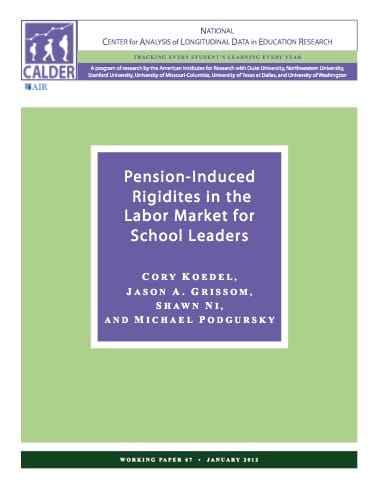 Long overshadowed by sexier education-reform topics, pension
reform has gained allure in recent months. This paper—written by
University of Missouri economist Mike Podgursky and colleagues—adds yet more
intrigue to the pension-reform debate: It examines the impact of “pension
borders” (lines dividing districts or states with variant pension benefits) on
the mobility of school leaders. In other words, does leaving one pension system
for another—and thus incurring substantial pension loss—discourage principals
from swapping posts? In a word, yes. Using simulation techniques, analysts
examine eighteen years of panel data from Missouri (1992 to 2010) and find that
pension borders represent a substantial impediment to principal mobility. (Missouri was chosen as the case study because the state
has three distinct pension systems: for Kansas City,
for St. Louis,
and for the rest of the state. With no reciprocity among these systems, they
are as distinctly different as systems are across state lines.) Removing a
pension border between two groups of schools, the analysts found, would roughly
double leadership flows among them. This paper
offers both valuable insight into this budding issue and a smart warning
to states and districts: How retirement benefits are structured is at odds with
making the principal labor market more fluid. It’s high time we fix that.
Long overshadowed by sexier education-reform topics, pension
reform has gained allure in recent months. This paper—written by
University of Missouri economist Mike Podgursky and colleagues—adds yet more
intrigue to the pension-reform debate: It examines the impact of “pension
borders” (lines dividing districts or states with variant pension benefits) on
the mobility of school leaders. In other words, does leaving one pension system
for another—and thus incurring substantial pension loss—discourage principals
from swapping posts? In a word, yes. Using simulation techniques, analysts
examine eighteen years of panel data from Missouri (1992 to 2010) and find that
pension borders represent a substantial impediment to principal mobility. (Missouri was chosen as the case study because the state
has three distinct pension systems: for Kansas City,
for St. Louis,
and for the rest of the state. With no reciprocity among these systems, they
are as distinctly different as systems are across state lines.) Removing a
pension border between two groups of schools, the analysts found, would roughly
double leadership flows among them. This paper
offers both valuable insight into this budding issue and a smart warning
to states and districts: How retirement benefits are structured is at odds with
making the principal labor market more fluid. It’s high time we fix that.
Cory Koedel, Jason A. Grissom, Shawn Ni, and Michael Podgursky, “Pension-Induced Rigidities in the Labor Market for School Leaders” (Washington, D.C.: National Center for Analysis of Longitudinal Data in Education Research, January 2012.)

